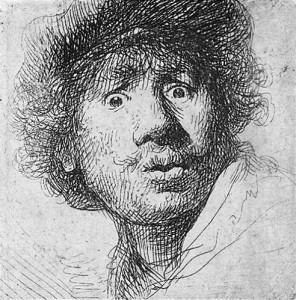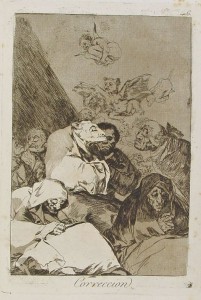I have been thinking about the reason artists use printmaking to produce their works when they could draw sketches. I remembered Rembrandt, by whom Goya was influenced, and his innovative use of the medium, Rembrandt revolutionized printmaking by simple additions that made a drastic difference in his art. Rembrandt used a soft ground of his own devising to protect the acid plate which allowed him great flexibility in his use of the etching needle that is close to that of drawing with a crayon. Rembrandt’s lines were quite flexible and his influence on Goya is clear. It is mostly clear in the way his portrayal of the grotesque is mitigated, the wrinkles in the old people’s faces in Correction do not make looking at them difficult for the audience, but the point about their old age or being metamorphoses is delivered.
This self-portrait by Rembrandt demonstrates his flexible technique and his mastery of portraying vivid emotions on his subject’s face, the expression is quite bewildering, it could be disbelief or fear or a mix of both.
In Goya’s Correction the demon figures are drawn in a flexible technique that is close to Rembrandt’s style and the difference in focus between the demons, the shady figures to the left and the white figures in the right side could be inspired by Rembrandt’s style.
Apparently, artists used printmaking because it mostly allowed for a freedom and subtlety that is not found in un-colored sketches. Rembrandt is a pioneer of printmaking although he is not one of the very first artists who devised this technique. Even in techniques so flexible as Goya’s viewers can have some idea of visual textuality: the difference in focus between the characters, the careful distortion of the people’s features in a way not too repulsive, but just enough to drive his point home, the balance in the arrangement of characters (notice how there are two white figures to the right, two shady figures to the left), and the juxtaposition of all such elements produces the illustration of an idea that does not need words to be clear, it is readable on its own if viewers are familiar with the social context from which the idea comes. This reveals how printmaking is quite an intelligent practice.
However, does that mean that every artist, in printmaking or painting, had visual textuality on mind when he was composing an artwork?


